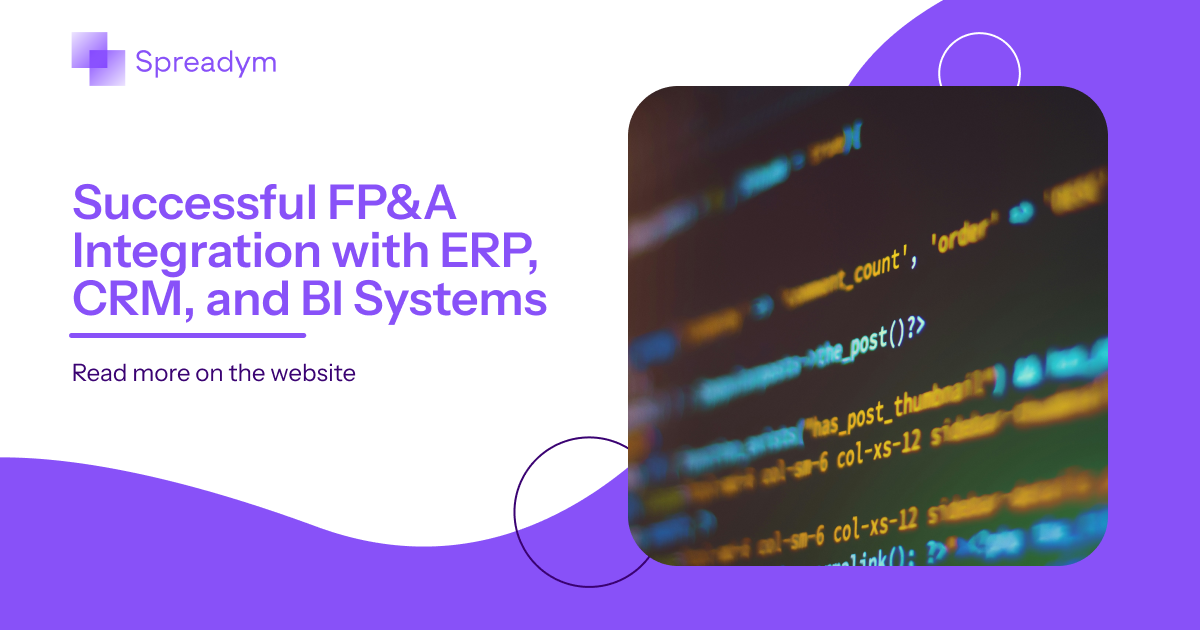In a world of growing competition and uncertainty, businesses need transparent and timely analytics. An effective FP&A (Financial Planning and Analysis) function is becoming critically important—especially when it is tightly integrated with a company’s core information systems: ERP, CRM, and BI.
In this article, we’ll explore:
In this article, we’ll explore:
- why integration is essential;
- what pitfalls may arise;
- and how to build an effective data architecture to support strategic decision-making.
Why Integrate FP&A with Other Systems?
The primary goal of an FP&A platform is to become a unified system for modeling the planning process, which makes its connection to accounting, analytics, and customer management systems particularly important.
1. Reducing Manual Work
Integration eliminates the need to copy data from Excel or manually export reports from ERP and CRM, accelerating the planning and analysis process.
2. Improving Forecast Accuracy
FP&A gains access to real-time data on sales, expenses, inventory, and customer activity, enabling the creation of more accurate budgets and forecasts.
3. Supporting Real-Time Decision-Making
When data is automatically collected and processed through BI tools, companies can respond quickly to market changes and adjust plans in real time.
1. Reducing Manual Work
Integration eliminates the need to copy data from Excel or manually export reports from ERP and CRM, accelerating the planning and analysis process.
2. Improving Forecast Accuracy
FP&A gains access to real-time data on sales, expenses, inventory, and customer activity, enabling the creation of more accurate budgets and forecasts.
3. Supporting Real-Time Decision-Making
When data is automatically collected and processed through BI tools, companies can respond quickly to market changes and adjust plans in real time.
Which Systems Are Most Commonly Integrated with FP&A?
In theory, FP&A can be integrated with any system, including warehouse management. However, it’s important to evaluate data sufficiency during integration—ensuring the model uses only the necessary data without overloading the system.
We recommend starting with integration to the following systems:
We recommend starting with integration to the following systems:
- ERP Systems: These provide financial and operational data. Integration allows automatic retrieval of income, expenses, and balance information.
- CRM Systems: These help manage customer relationships and offer valuable data for revenue forecasting and sales funnel analysis.
- BI Tools: These enable intuitive data visualization and bring together all sources and key model indicators into a format optimized for analysis.
Key Elements of Successful Integration
1. Establishing a Unified Data Repository (Data Warehouse / Data Lake)
This becomes the "magnet" that draws in data from all systems—with cleansing, transformation, and standardization.
2. Using ETL/ELT Processes
Automated data pipelines (e.g., via Apache Airflow, Talend, or built-in Power BI tools) ensure timely and reliable data uploads.
3. Strong Data Governance
A shared data dictionary, metadata management, and quality control are critical. Without consistent data policies, integrations quickly degrade.
4. Selecting a Flexible FP&A Platform
Solutions like Spreadym, Anaplan, Jedox, and Adaptive Planning are designed to integrate and process external data from day one.
5. Cross-Functional Team Collaboration
Finance + IT + Data Analysts. Only through joint efforts can an efficient data architecture be created.
This becomes the "magnet" that draws in data from all systems—with cleansing, transformation, and standardization.
2. Using ETL/ELT Processes
Automated data pipelines (e.g., via Apache Airflow, Talend, or built-in Power BI tools) ensure timely and reliable data uploads.
3. Strong Data Governance
A shared data dictionary, metadata management, and quality control are critical. Without consistent data policies, integrations quickly degrade.
4. Selecting a Flexible FP&A Platform
Solutions like Spreadym, Anaplan, Jedox, and Adaptive Planning are designed to integrate and process external data from day one.
5. Cross-Functional Team Collaboration
Finance + IT + Data Analysts. Only through joint efforts can an efficient data architecture be created.
Practical Recommendations
- Start with high-priority use cases — for example, revenue forecasting based on CRM and ERP data.
- Build an MVP — a minimally viable integration that can be quickly tested.
- Scale gradually — add more sources, refine models and reports over time.
- Invest in user training — users must understand how the data works and trust the system.
Integrating FP&A with key systems is not just a technical project—it’s a strategic investment in business agility and control. It enables a shift from reactive to proactive management, shortens decision-making cycles, and transforms finance into a true business partner.


